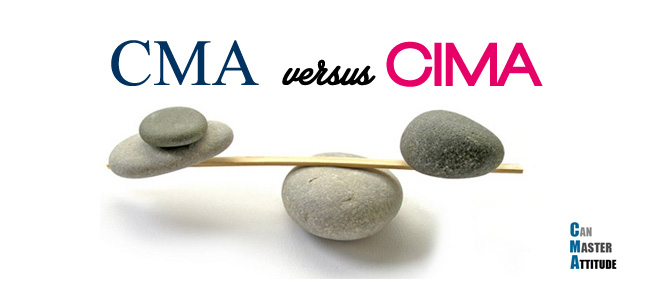- You are here:
- Home »
- Blog »
- CIMA Exam »
- CMA vs CIMA: Which is Better? Which Qualification Should You Go For?
CMA vs CIMA: Which is Better? Which Qualification Should You Go For?

CMA vs CIMA: An Overview
The CMA qualification discussed here is the one granted by the Institute of Management Accountants, also known as the IMA. CIMA, which stands for Chartered Institute of Management Accountants, is a designation from the UK.
Membership and Network
Both qualifications were established a long time ago, but CIMA has a much larger presence with over 689K members, students, and associated professionals across the globe. The IMA has around 100,000 members in comparison.
Global Presence
In terms of international presence, CIMA traditionally has a more global presence and is well recognized in most places — less so in the US but more so in the UK and Commonwealth countries. In recent years, the CMA (now CPA) Canada and CMA Australia are getting more popular in their respective countries, so CIMA is arguably less sought after in these countries.
On the other hand, IMA has been actively building up its global presence, notably in emerging countries like China and the Middle East. For now, CMA is well established in China and is head-to-head with CIMA in the Middle East.
At the same time, CIMA has paired up with the AICPA to establish a new qualification known as the CGMA.
Here is a summary based on my observations:
- US: CMA much more recognized
- UK and Commonwealth countries: CIMA is much more recognized, less so for Canada and Australia
- Canada: CPA Canada is the best; CMA is slightly better than CIMA
- Middle East: CMA and CIMA have similar standing
- China: CMA considerably more recognized
Mutual Reciprocal Agreements
CIMA has an MOU with ICAI in India and alliances in various degrees with other universities and accounting associations. The agreement with CMA Canada is subject to change due to the unification of CA/CMA/CGMA in Canada.
The IMA has a strategic alliance with the ACCA that allows ACCA full members to qualify for the CMA exam automatically.
Educational Requirements
A bachelor’s degree is required to qualify for the CMA exam (exemptions are given to full ACCA members). This is not required for the CIMA because the CIMA itself offers a more rigorous program.
Exam Content, Format, and Duration
In this regard, CMA is quite obviously more favorable to those who want to get a qualification fast. It is a 2-part exam, and most candidates aim to finish within one year. Candidates can take the exam anytime within the testing windows open 6 months out of each year.
To become a CIMA, the candidate must pass the 12 papers, complete at least 3 years of qualifying practice, and obtain verification and endorsement from supervisors. It takes a lot more time, effort, and commitment.
Exam Costs
Lastly, on cost, since CMA only has two exam parts, the exam fee is substantially lower than that for the CIMA exam. Also, there is little competition in the CIMA review materials, so they are very expensive.
The average cost to complete the CMA program is US$2,200 – 3,700, versus US$6,800 for the CIMA Professional Qualification program.
Conclusion
There isn’t a “better” or “easier” qualification. As fellow reader Gunner pointed out in the comment section, while the CMA may look easier with only two parts in the exam, it requires a bachelor’s degree vs. a high school diploma in CIMA. Or looking at it the other way, because CIMA has a lower entry barrier, it has a more comprehensive exam with more papers and time/effort in the preparation.
A more important consideration is where you would like to work in the longer term. This will help you select the qualification best suited to that region.
More Discussions on the Internet
Here are more discussions on CMA vs CIMA in various articles and forums. Some forums are more biased than others, so please use your discretion when reading the information.
- Comparing major management accounting certifications around the world
- Number of CIMA members and students in respective countries
Can I Be More Helpful?
If you like this article, please sign up for my e-course, which is completely free. You can learn about the mini e-course here or sign up directly below:
Join us if you want to get tips on how to plan,
study and pass your CMA exam… on your first attempt!
About the Author Stephanie Ng
I am the author of How to Pass The CPA Exam (published by Wiley) and the publisher of this and several accounting professional exam prep sites.
